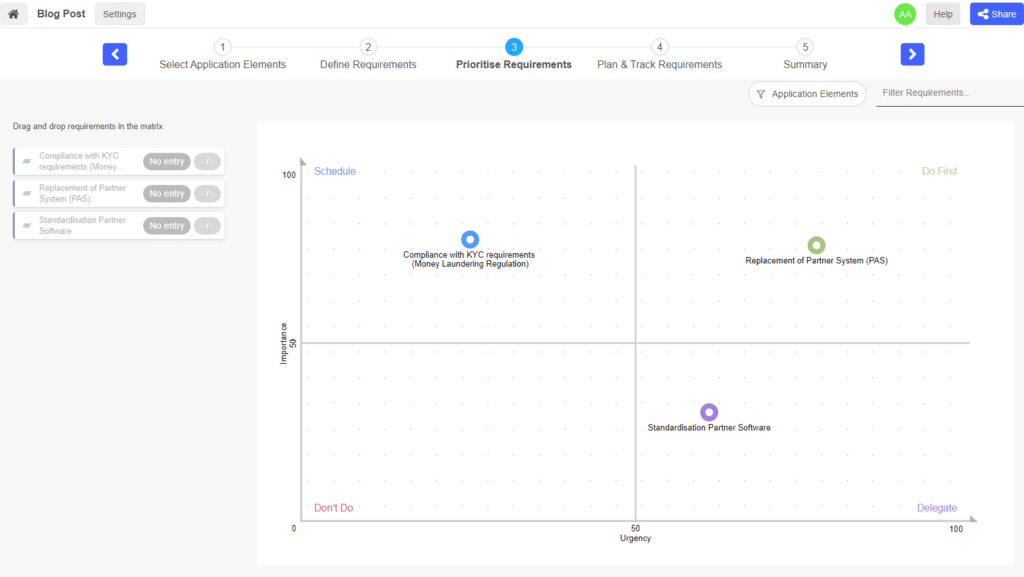Found this helpful? Share it with peers.
Introduction
In today’s fast-paced business environment, prioritizing strategic requirements is crucial element of success. With limited resources and numerous demands, organizations must allocate their time, money, and efforts wisely. Prioritization helps ensure that the most important strategic requirements are addressed first, enabling businesses to achieve their goals efficiently. In this blog post, we will explore some effective strategies and techniques to help you prioritize your strategic requirements and make informed decisions for your organization’s success.

Define Strategic Requirements
Before prioritizing your requirements, it’s essential to first define them. There are various ways to do so. For example, you might want to structure them according to your organization’s:
Goals
Start by defining your strategic objectives and aligning them with your overall mission and vision. Make sure that these goals are SMART – Specific, Measurable, Attainable, Relevant, Time-bound. When your goals are well-defined, you can better identify the strategic requirements necessary to achieve them. So, ask yourself the following questions:
What are the short- and long-term goals of your organization? How can you reach them?
Hint: Read more about the Art of Strategic Management and how to navigate the path to long-term business success in our blog post.
Capabilities
Start by assessing your organization’s core competencies. Identify the areas where your organization excels and the areas that require improvement. This introspection will help you determine the strategic requirements necessary to leverage your strengths and address your weaknesses.
So, what are your organization’s main capabilities? What do you need to do to be able to realize them?
Hint: Get an overview of your capabilites with a business capability map – dive into our free capability portfolio management e-learning course to learn more!
Applications
Sometimes, it makes sense to start directly with your IT portfolio. In this case, applications are a good starting point. Start by assessing the various components of your organization’s applications, such as software, platforms, and technologies. Identify the critical functionalities, features, and integration points that are necessary to support your strategic objectives. This evaluation will help you determine the strategic requirements needed to enhance your application ecosystem and align it with your organizational goals.
So, what are the most important application elements of your organization? Are there any significant changes that entail the integration of digital technologies into various facets of an organization, fundamentally altering its operations and the way it provides value to its customers?
By answering these questions, you are defining your requirements.
Hint: See how to set it up in our Application Portfolio free poster!
Evaluate and Rank Strategic Requirements
Now, you can evaluate and rank your strategic requirements. Assess each requirement based on factors such as impact, urgency, cost, and alignment with organizational values. The best way to do so, is to come up with a sort of a questionnaire and evaluate each requirement according to the same set of criteria.
Next, rank the requirements by assigning a priority level to each one. Consider the potential benefits and risks associated with each requirement. Use techniques like:
- Value vs. Effort Matrix to prioritize the high-value requirements and postpone those with lower value and high effort.
- Eisenhower Matrix to prioritize requirements with high importance and urgency, over those that are less important or urgent.
- Three Horizons Model which allows you to visualize your requirements with their time to value ratio.
Example of an Eisenhower Matrix in the EA Suite ADOIT
Collaborate and Seek Stakeholder Input
When prioritizing strategic requirements, involving relevant stakeholders is vital. Engage with individuals or teams who have expertise or are impacted by the requirements. Seek their input and gather diverse perspectives. This collaborative approach ensures that all important aspects are considered and helps build consensus around the prioritization decisions. It also fosters a sense of ownership and commitment among stakeholders. So, include them in the entire process: from defining the requirements and answering the survey questions, to creating the final roadmap.
Hint: Learn more about strategic roadmapping in our blog post!

Continuously Reassess and Adapt
Prioritization is an ongoing process. As circumstances change, strategic goals may evolve, and new requirements may emerge. It is essential to regularly reassess and adapt your prioritization approach. Set up regular review cycles to evaluate the progress of each requirement and make adjustments as needed. Stay flexible and be open to reprioritizing based on new information or shifting business priorities.
Summary
Effectively prioritizing strategic requirements is essential for organizations to allocate their limited resources wisely and achieve their goals. By defining clear strategic goals, evaluating and ranking requirements, analysing resource availability, collaborating with stakeholders, and continuously reassessing and adapting, businesses can make informed decisions that maximize their chances of success.
Prioritization is a dynamic process, requiring regular review and adjustments to stay aligned with changing business needs. By implementing these strategies, organizations can optimize their strategic focus and drive sustainable growth in today’s competitive landscape.







